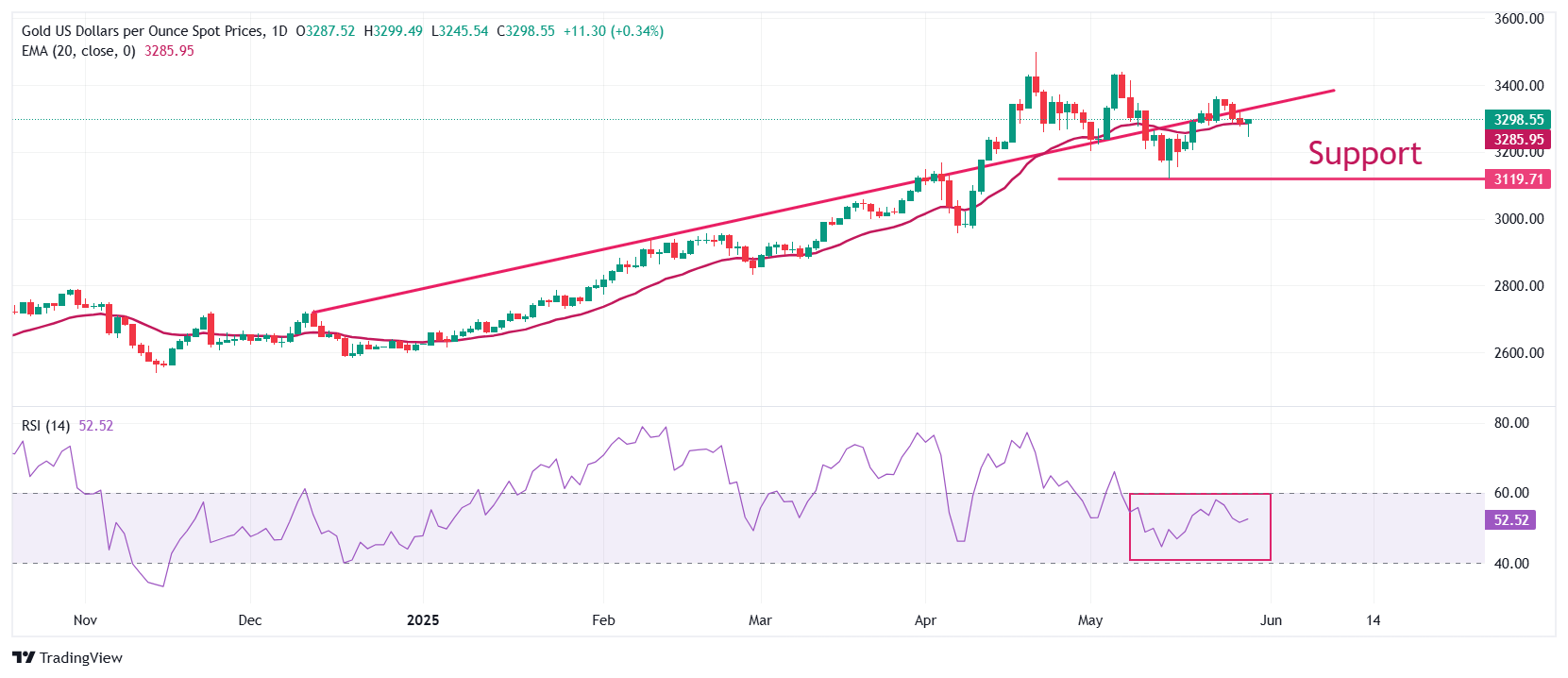Created
: 2025.05.29














![]() 2025.05.29 19:59
2025.05.29 19:59
Gold price (XAU/USD) claws back the majority of its initial losses in Thursday's European trading session, recovers to near $3,300 from the weekly low of $3,245 posted earlier in the day. The yellow metal bounces back as the US Dollar (USD) gives up its early gains in the aftermath of the legal roadblock on United States (US) President Donald Trump's tariff policy.
The US Dollar Index (DXY), which tracks the Greenback's value against six major currencies, surrenders initial gains and flattens slightly below 100.00 at the time of writing. Technically, a lower US Dollar makes the Gold price a value bet for investors.
On Wednesday, New York's federal court accused US President Trump of violating the constitutional limit of the International Emergency Economic Powers Act (IEEPA) for fulfilling his tariff agenda, the Associated Press (AP) reported. The Manhattan-based court ordered the administration to lift import duties within ten days, to which the White House immediately appealed the decision.
In April, Trump announced reciprocal tariffs for all of his trading partners and additional duties on Canada, Mexico, and China for border negligence and pouring fentanyl into the US economy. He declared a national emergency under the IEEPA to justify levies. This suggests that the imposition of tariffs by Trump on automobiles, steel, aluminum, and semiconductors remains intact.

Gold price recoups early losses but continues to struggle around the upward-sloping trendline on a daily timeframe around $3,335, which is plotted from the December 12 high of $2,726. The near-term trend of the precious metal is uncertain as it wobbles around the 20-day Exponential Moving Average (EMA), which trades near $3,286.
The 14-day Relative Strength Index (RSI) oscillates inside the 40.00-60.00 range, suggesting indecisiveness among market participants.
Looking up, the May 7 high around $3,440 will act as key resistance for the metal. On the downside, the May 15 low at $3,120.83 will be the key support zone.
Gold has played a key role in human's history as it has been widely used as a store of value and medium of exchange. Currently, apart from its shine and usage for jewelry, the precious metal is widely seen as a safe-haven asset, meaning that it is considered a good investment during turbulent times. Gold is also widely seen as a hedge against inflation and against depreciating currencies as it doesn't rely on any specific issuer or government.
Central banks are the biggest Gold holders. In their aim to support their currencies in turbulent times, central banks tend to diversify their reserves and buy Gold to improve the perceived strength of the economy and the currency. High Gold reserves can be a source of trust for a country's solvency. Central banks added 1,136 tonnes of Gold worth around $70 billion to their reserves in 2022, according to data from the World Gold Council. This is the highest yearly purchase since records began. Central banks from emerging economies such as China, India and Turkey are quickly increasing their Gold reserves.
Gold has an inverse correlation with the US Dollar and US Treasuries, which are both major reserve and safe-haven assets. When the Dollar depreciates, Gold tends to rise, enabling investors and central banks to diversify their assets in turbulent times. Gold is also inversely correlated with risk assets. A rally in the stock market tends to weaken Gold price, while sell-offs in riskier markets tend to favor the precious metal.
The price can move due to a wide range of factors. Geopolitical instability or fears of a deep recession can quickly make Gold price escalate due to its safe-haven status. As a yield-less asset, Gold tends to rise with lower interest rates, while higher cost of money usually weighs down on the yellow metal. Still, most moves depend on how the US Dollar (USD) behaves as the asset is priced in dollars (XAU/USD). A strong Dollar tends to keep the price of Gold controlled, whereas a weaker Dollar is likely to push Gold prices up.
![]()
Created
: 2025.05.29
![]()
Last updated
: 2025.05.29

FXStreet is a forex information website, delivering market analysis and news articles 24/7.
It features a number of articles contributed by well-known analysts, in addition to the ones by its editorial team.
Founded in 2000 by Francesc Riverola, a Spanish economist, it has grown to become a world-renowned information website.
We hope you find this article useful. Any comments or suggestions will be greatly appreciated.
We are also looking for writers with extensive experience in forex and crypto to join us.
please contact us at [email protected].
Disclaimer:
All information and content provided on this website is provided for informational purposes only and is not intended to solicit any investment. Although all efforts are made in order to ensure that the information is correct, no guarantee is provided for the accuracy of any content on this website. Any decision made shall be the responsibility of the investor and Myforex does not take any responsibility whatsoever regarding the use of any information provided herein.
The content provided on this website belongs to Myforex and, where stated, the relevant licensors. All rights are reserved by Myforex and the relevant licensors, and no content of this website, whether in full or in part, shall be copied or displayed elsewhere without the explicit written permission of the relevant copyright holder. If you wish to use any part of the content provided on this website, please ensure that you contact Myforex.
Myforex uses cookies to improve the convenience and functionality of this website. This website may include cookies not only by us but also by third parties (advertisers, log analysts, etc.) for the purpose of tracking the activities of users. Cookie policy